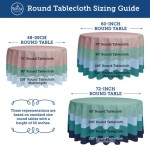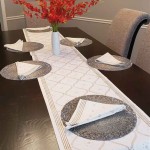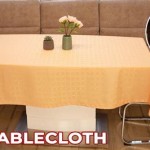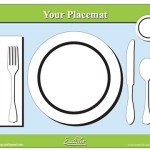How To Measure an Oblong Table for a Tablecloth
Selecting the right tablecloth for an oblong table involves more than just aesthetics; it requires accurate measurements to ensure a proper fit and desired drape. A tablecloth that is too small will appear inadequate and fail to protect the table surface, while one that is too large can be cumbersome and visually unappealing. This article provides a comprehensive guide on how to measure an oblong table for a tablecloth, covering the necessary steps, considerations for desired drape, and tips for achieving a polished and functional table setting.
Understanding the Required Measurements: Length and Width
The fundamental measurements needed for determining the appropriate tablecloth size for an oblong table are its length and width. These dimensions form the basis for calculating the overall size of the tablecloth required to achieve the desired look. Failing to accurately measure these dimensions can lead to significant discrepancies in the final fit.
To begin, use a measuring tape to determine the table's length. Extend the measuring tape from one end of the table to the other, ensuring it runs along the longest dimension. Record this measurement in inches or centimeters, depending on the preferred unit of measurement. Accuracy is paramount; therefore, double-check the measurement to minimize errors.
Next, measure the table's width. Extend the measuring tape from one side of the table to the other, perpendicular to the length measurement. Ensure the measuring tape is straight and taut to obtain an accurate reading. Record this measurement in the same units as the length. Again, it is advisable to double-check the measurement.
It is crucial to measure the table surface directly, rather than relying on manufacturer specifications or estimations. Table dimensions can vary slightly due to manufacturing tolerances, and relying on inaccurate figures can lead to a poorly fitting tablecloth. Using a flexible measuring tape is recommended, as it can easily conform to the table's edges. If the table has any rounded edges or unusual features, it is important to account for these when taking measurements.
Once the length and width are accurately determined, these figures serve as the foundation for calculating the overall tablecloth size. The next step involves determining the desired drop, which will be added to these measurements to ensure the tablecloth hangs appropriately over the table edges.
Calculating the Desired Drop: Achieving the Perfect Drape
The drop refers to the amount the tablecloth hangs over the table's edge. This is a crucial element in determining the overall aesthetic appeal of the table setting. The desired drop can vary depending on the formality of the occasion and personal preferences. Common drop lengths range from 6 inches to 12 inches, but longer drops are also used for more formal settings.
For casual occasions and everyday use, a drop of 6 to 8 inches is generally considered appropriate. This provides sufficient coverage without being overly formal or cumbersome. For more formal occasions, such as dinner parties or holiday gatherings, a drop of 10 to 12 inches is often preferred. This longer drop creates a more elegant and sophisticated look. For very formal events or grand occasions, a floor-length drop (approximately 29-30 inches) may be desired. However, floor-length tablecloths are less practical for everyday use due to potential tripping hazards and increased maintenance.
Determining the desired drop involves measuring from the table's edge to the point where the tablecloth should end. This measurement should be taken on all four sides of the table to ensure consistency. If the table sits on a rug, consider the rug's thickness when determining the drop length. The tablecloth should ideally clear the rug to prevent it from bunching up or dragging on the floor.
Once the desired drop is determined, this measurement must be added to both the length and width measurements of the table. For example, if the table is 60 inches long and 36 inches wide, and a 10-inch drop is desired, the required tablecloth size would be calculated as follows: Length: 60 inches (table length) + 10 inches (drop) + 10 inches (drop) = 80 inches. Width: 36 inches (table width) + 10 inches (drop) + 10 inches (drop) = 56 inches. Therefore, an 80-inch by 56-inch tablecloth would be required.
It is important to note that these calculations assume a symmetrical drop on all sides of the table. If a different drop length is desired for the ends versus the sides, the calculations should be adjusted accordingly. Accurate drop calculations are essential for ensuring the tablecloth fits properly and achieves the desired aesthetic effect.
Considering Fabric Shrinkage and Hem Allowance
After calculating the initial tablecloth size based on table dimensions and desired drop, it is crucial to consider potential fabric shrinkage and hem allowance. Most fabrics will shrink slightly after the first wash, and this shrinkage can affect the overall fit of the tablecloth. Additionally, a hem is necessary to finish the edges of the tablecloth and prevent fraying.
To account for fabric shrinkage, it is recommended to add an extra allowance to the calculated tablecloth size. The amount of shrinkage varies depending on the type of fabric. Natural fibers, such as cotton and linen, tend to shrink more than synthetic fibers. A general rule of thumb is to add 3% to 5% to both the length and width measurements to compensate for shrinkage. If the fabric manufacturer provides specific shrinkage information, it is best to use that data to determine the appropriate allowance.
For example, if the calculated tablecloth size is 80 inches by 56 inches, and a 3% shrinkage allowance is desired, the additional allowance would be calculated as follows: Length Allowance: 80 inches x 0.03 = 2.4 inches. Width Allowance: 56 inches x 0.03 = 1.68 inches. Therefore, the adjusted tablecloth size, accounting for shrinkage, would be approximately 82.4 inches by 57.68 inches. However, since tablecloths are typically sold in standardized sizes, it may be necessary to round up to the nearest available size.
In addition to shrinkage allowance, it is also important to consider the hem allowance. A hem is a folded and stitched edge that provides a clean finish and prevents fraying. The width of the hem can vary depending on personal preference and the type of fabric. A standard hem width is typically between 0.5 inches and 1 inch. This hem allowance needs to be factored into the overall tablecloth size.
To incorporate the hem allowance, add twice the desired hem width to both the length and width measurements. For example, if the adjusted tablecloth size is 82.4 inches by 57.68 inches, and a 0.75-inch hem is desired, the final tablecloth size would be calculated as follows: Length: 82.4 inches + (0.75 inches x 2) = 83.9 inches. Width: 57.68 inches + (0.75 inches x 2) = 59.18 inches. Again, it may be necessary to round up to the nearest available size when purchasing a tablecloth.
By carefully considering fabric shrinkage and hem allowance, the final tablecloth will fit properly even after washing and will have a polished, finished look. Failing to account for these factors can result in a tablecloth that is too small after the first wash or has unfinished edges.

Tablecloth Size Calculator Williams Sonoma Taste

Tablecloth Size Calculator Find The Right

Oval Boho Tablecloth For Table Covers Wrinkle Free Bohemian Style Design Cloth Dining Room Tabletop Decoration 60 X 102 Inch Retro Colorful Pattern Print Orange Red Com

Tablecloth Size Calculator Oval Table Cloth Sizes

What Size Tablecloth Do I Need Deconovo Us

Tablecloth Sizes Ilrated Charts Guide Table Cloth Dining

Tablecloth Size And How To Choose The Right One

Tablecloth Size Calculator Find The Right

3 Easy Ways To Measure Tablecloth Sizes Your Table Linens Size Guide

How To Choose The Correct Size Tablecloth For Your Table
Related Posts








